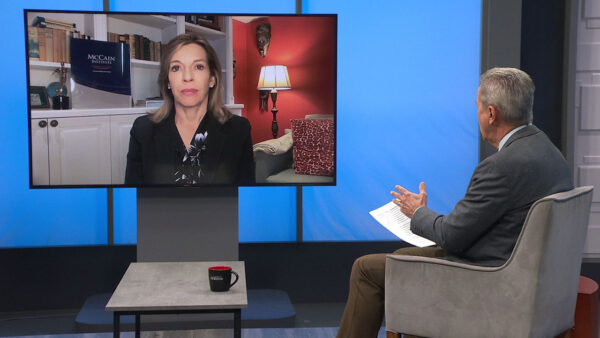In late April, about 160 volunteers scoured the streets of Phoenix, Glendale and Mesa in search of the Valley’s homeless. It’s part of Project H3, a national effort to place the most medically vulnerable homeless people into homes. Learn more about the project from Mattie Lord, State Homeless Coordinator for the Arizona Department of Economic Security; Michael Shore, President and CEO of HOM, Inc.; and Brad Bridwell, the Homeless Veterans Coordinator for the Arizona Department of Veterans Services.
Ted Simons:
Part of project H3 -- home, health, hope, a national effort to place America's most medically vulnerable people into homes. Here with more are three of its coordinators - Mattie Lord, Michael Shore, President of Home Incorporated, and Brad Bridwell, Homeless Veterans Coordinator for the Arizona department of veteran services. Thanks for joining us.
Mattie Lord:
Thank you for having us.
Ted Simons:
A brief synopsis, but give us an overview what the program was looking for and what you found.
Mattie Lord:
The goal is to identify and house with the support services at least the 50 most medically vulnerable adults. We're the 19th city to initiate this as part of a campaign. Led by common ground out of New York. It's a collaborative effort of more than 50 organizations that have come together and set aside their own identities and come together under project H3. To change the system, to shift from managing homelessness to ending it and to save lives.
Ted Simons:
Talk to us how the survey was done and -- I know there was a vulnerability index involved. Who are were you looking for and how did you find them?
Michael Shore:
It was a tool we got from common ground. They developed it out of research from Boston healthcare for the homeless. Dr. Jim O'Connor. It takes a look at indicators. Look at liver disease and end stage renal disease. Having HIV or aids. History of hospitalizations and trimorbidity -- someone with mental illness combined with chronic disease that I mentioned.
Ted Simons:
Let's talk about -- I know that veterans obviously a concern. But age, needs, violence, tendency to all of these things. What was found?
Brad Bridwell:
10% of the population surveyed altogether were 60 years and older. So really a good component, aging rapidly. And becoming more and more vulnerable. We also have about 36% report being the victims of violence during the episodes of homelessness with 24% surprisingly having mild brain injuries as well. Overall, 21% were veterans, which is what we would expect to see. Overall, they're about 20% in the homeless population and each of those as we start to look at the different categories of kind of how they fall; we can start to see what housing opportunities are available for those individuals, whether it be veteran-related housing or whether it be age-specific housing.
Ted Simons:
And looking at video right now of folks on the street and getting in contact with some of these folks. As far as getting in contact, talk about the challenges of undergoing a study like this and some of the things that you have to be concerned about and the information you need to get. How difficult it is to get that information.
Mattie Lord:
Well, I think the hardest part we found going out at 4:00 in the morning was finding the people experiencing Street homelessness. They tend to hide well. Each of us was assigned a small geographic area which we combed each of the three mornings and revisiting and we found new people each time and we had to wake them up to where they were coherent to conduct an interview. And I think the greater challenge is going back out to find them again and we did specific things in the survey so we could find them again to get them housed and the services they need. Noted where they were sleeping and took pictures with their consent and asked them where they spent their time during the day and asked if there was a particular outreach worker they knew and trusted.
Ted Simons:
Trust, I would imagine, would be a major factor here, correct?
Michael Shore:
Absolutely.
Ted Simons:
And how -- how were the workers, the researchers, how are folks able to gain that trust?
Michael Shore:
It was a great experience. On Monday night, we received training from Becky cane of the common ground on using the vulnerability index and 36 teams and each were composed of a professional outreach worker and then laypersons. Many were from the human services agencies we work with but there were also teachers and business people and the outreach workers did their job of engaging the person and getting them to feel comfortable but it was the actual volunteer who would ask the questions and get at the data we were looking for.
Brad Bridwell:
You would think would be a challenge, the recruitment of volunteers and getting the community involved at going out at 4:00 in the morning. We had to cut off our volunteer participation at 163. They came out with touching stories through the week and we have Chandler teachers ready to join homeless outreach as their profession. It's that good and responsive. We held a community briefing on Friday and within 10 minutes had all 50 individuals sponsored at the equivalent of $1,000 a piece for move-in items like furniture and beds and now we're on to housing.
Ted Simons:
Indeed, and now on to, as far as our discussion is concerned, what do we do with the information. What gets done with the facts and figures?
Mattie Lord:
We have a list now of the people most vulnerable and order of vulnerability of the 262 interviews, 106 were medically vulnerable and we rank ordered them. We have the housing and support services for the first 50. Since Friday, we've scooped up four of them on our top 10 list and placed them in temporary housing. Those four gentlemen had 78 years on the street collectively.
Ted Simons:
Wow! With that kind of initial success, sounds like there's encouragement out there. Like folks can't wait to help. But how far can this go? Where do we go from here?
Michael Shore:
I think we hope to house all 50 probably within the next six to nine months. I think we committed to doing that by July of 2011 but I'm confident we'll get it done sooner. I think this is a demonstration project and we want to see and show the community placing somebody into housing is a better model for ending homelessness rather than trying to manage their homelessness on the street. It's not a Band-Aid. It's a permanent solution.
Ted Simons:
Is that how you see it now?
Brad Bridwell:
Absolutely, especially when you talk about elongated homelessness where individuals have trouble navigating temporary help systems throughout their bout with homelessness and experience. If we don't target that population in a very, very different way, we won't end Street homelessness. So this is among our first efforts to really change the way we do business and the way we end homelessness, whether that be veteran homelessness or otherwise.
Ted Simons:
I know you work in this business here, this service, where do the homes come from? Where do you find the homes?
Michael Shore:
There's a number of different programs, typically from HUD. Funded, strategically for the homeless population. But then there's also mainstream HUD resources dedicated to other populations and it's really I think the innovative piece of our program is we're looking at what exists in our community already and how do we access those resources.
Ted Simons:
And once the 50 are found and can perhaps get off the street and find hopes, are you ready for the next 50?
Mattie Lord:
I think we are. We're gearing up.
Ted Simons:
Plans are in place.
Mattie Lord:
We're hope. We have the support services we need to identify, but we remain hopeful. With the momentum we've gained with the first 50 and if we can demonstrate success, the resources will follow for the next 50.
Ted Simons:
Let's hope to see and we'll get you back on the show and talk about the next 50.
Mattie Lord:
Thank you.
Mattie Lord:State Homeless Coordinator, Arizona Department of Economic Security;Michael Shore, President and CEO, HOM, Inc.;Brad Bridwell, Homeless Veterans Coordinator,Arizona Department of Veterans Services;























